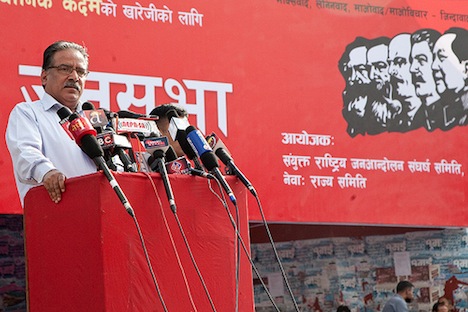Nepal, a Hindu Himalayan state of nearly 27 million people isn’t generally on the radar screens of international policymakers. ![]()
But it should be — the country is nestled between the world’s two most populous countries (and increasingly, economic powers), China and India.
Over the course of the last week, it’s become increasingly clear that the once-dominant Unified Communist Party of Nepal (Maoist) (UCPN-M, एकीकृत नेपाल कम्युनिष्ट पार्टी (माओवादी)) suffered a huge setback in the November 19 elections to the constituent assembly, leaving a once revolutionary rebel group smarting and alleging fraud in the initial shock of defeat, despite no real evidence of electoral malfeasance.
By way of background, Nepal’s elections followed a very rough transition from over two centuries of monarchy to an imperfect democracy. Despite reforms over the monarchies of King Mahendra and King Birendra in the last half of the 20th century, democratic reformers continually pushed for larger openings. Nepal’s precarious situation took a turn for the worst in 1996, when the UPCN-M launched a war against the monarchy for the purpose of abolishing it and replacing it with a people’s republic, under the leadership of Pushpa Kamal Dahal (pictured above), commonly known as ‘Prachanda.’ The massacre of the entire royal family in 2001 and the subsequent failure of Gyanendra, Birendra’s brother and his successor, to stabilize Nepal, led to the end of the monarchy in 2008.
It also led to a set of elections in April 2008 for a constituent assembly, a 601-member body of representatives designed as a temporary government that would write a new constitution and govern for two years. The UCPN-M won those elections, and Prachanda became prime minister.
But within months, Prachanda resigned over a conflict with Nepal’s president over the firing of Nepal’s military chief, leading to a series of four prime ministers over the next four years, months-long stretches without a government and increasing dysfunction. Five years later, Nepal has no new constitution and after multiple delays, last month’s elections (originally scheduled for November 2012) were designed to elect a constituent assembly with a renewed mission.
Among the 240 seats elected on a first-past-the-post basis in last month’s elections, the UCPN-M won just 26. That stands in contrast to 105 seats won by the Nepali Congress (NC, नेपाली काँग्रेस), a more moderate party formed in the late 1940s in opposition to the absolute monarchy, and the 91 seats won by the Communist Party of Nepal (Unified Marxist–Leninist) (CPN-UML), a another moderately leftist party that has no relationship to Prachanda and the UCPN-M, although the UCPN-M supported the premiership of the CPN-UML’s Madhav Kumar Nepal between May 2009 and June 2010 and Jhala Nath Khanal between February 2011 and August 2011.
In the proportional vote, the Nepali Congress led with 25.5% and 91 seats, the CPN-UML narrowly followed with 23.7% and 84 seats, and the UCPN-M fell far behind to third place with just 15.2% and 54 seats. Prachanda himself was only narrowly elected to a seat in the constituent assembly.
So what does the result mean for Nepal and its future?
Prachanda seems to be backing away from calls for a new election in the absence of evidence of electoral fraud, but he and his party are still important to the future of Nepalese politics because the Nepali Congress and the CPN-UML are likely to fall just short of the two-thirds majority needed to enact a new constitution. Meanwhile, Baburam Bhattarai, the UCPN-M’s deputy leader and himself prime minister between August 2011 and February 2013, has called on his party to accept its defeat and work to reverse it by democratic means. But it also means that the new constitution, if it’s passed during the second constituent assembly, will be written more along the lines of the centralist vision of the Nepali Congress and the CPN-UML and less in the UCPN-M’s more federalized vision. But it’s a result for which Prachanda shares blame, given that he was unable to work with the other two dominant political parties to achieve a constitutional settlement over the past five years.
The Nepali Congress and the CPN-UML are likely to form a new coalition government (they’ve already started talking informally about the negotiation process) that’s likely to make NC leader Sushil Koirala, who started his political career in the 1950s as an activist for democracy, Nepal’s new prime minister.
